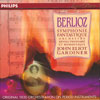Berlioz Symphonie fantastique
View record and artist detailsRecord and Artist Details
Composer or Director: Hector Berlioz
Label: Philips
Magazine Review Date: 6/1993
Media Format: Cassette
Media Runtime: 0
Mastering:
Stereo
DDD
Catalogue Number: 434 402-4PH

Tracks:
| Composition | Artist Credit |
|---|---|
| Symphonie fantastique |
Hector Berlioz, Composer
Hector Berlioz, Composer John Eliot Gardiner, Conductor Orchestre Révolutionnaire et Romantique |
Composer or Director: Hector Berlioz
Genre:
Orchestral
Label: Philips
Magazine Review Date: 6/1993
Media Format: CD or Download
Media Runtime: 53
Mastering:
Stereo
DDD
Catalogue Number: 434 402-2PH

Tracks:
| Composition | Artist Credit |
|---|---|
| Symphonie fantastique |
Hector Berlioz, Composer
Hector Berlioz, Composer John Eliot Gardiner, Conductor Orchestre Révolutionnaire et Romantique |
Author: John Warrack
In his preface, Gardiner sets out the issues again, and claims to ''recreate as closely as the available documentation permits the sound and atmosphere of the first performance''. The essential documentation is contained in Nicholas Temperley's edition of the score for the New Berlioz Edition, where he points out that a definitive version is not possible since different sources show changes. One such change is the cornet obbligato in the waltz, which certainly did not feature in the first performance: Gardiner includes this surely impermanent afterthought of Berlioz's, Norrington not. One may also point out that the instruments of Gardiner's orchestra, wind and brass very properly identified in the booklet, are often of later date than the symphony, even when they are not modern reproductions.
Nevertheless, even if we have here only an approximation to the sounds of the first performance, that is a good starting point. Gardiner's performance is in some ways sharper than Norrington's, and more insistent on detail. This can lead to over-phrasing, though he does almost nothing that cannot be justified from Berlioz's intricately, often oddly, marked score (a small misjudgement is the anticipation of a rallentando in the Ball, at 4'11''). He can also test audibility with his
Both performances are of endless fascination and enjoyment. Norrington is, in general, more concerned to use his recovered instrumental sounds to shape a performance of the kind with which we are familiar, cleaning everything up and presenting it afresh. He is thus more attentive to a smooth line for the idee fixe, to a steady, menacing tread for the ''Marche au supplice'', to mystery and atmosphere in the Ball and the opening of the Witches' Sabbath. Gardiner is perhaps more interested in the kind of performance with which Berlioz might have startled his audience that December night in 1830. So he plays the music with an extra emphasis on sudden flicks of phrasing, an extra abruptness in the stamp of a rhythm or the snap of an interrupting chord, a concern for the extreme.
Who can tell what the instruments really sounded like (for the whole question of playing traditions and techniques is so elusive of answer), and who knows how Habeneck really conducted the first performance, ''pas irreprochable'' as Berlioz found it? What matters is that we have, to set beside other well-loved performances with a modern orchestra, two that take us very close to the sound-world out of which Berlioz created a completely new kind of music.'
Discover the world's largest classical music catalogue with Presto Music.

Gramophone Digital Club
- Digital Edition
- Digital Archive
- Reviews Database
- Full website access
From £8.75 / month
Subscribe
Gramophone Full Club
- Print Edition
- Digital Edition
- Digital Archive
- Reviews Database
- Full website access
From £11.00 / month
Subscribe
If you are a library, university or other organisation that would be interested in an institutional subscription to Gramophone please click here for further information.





